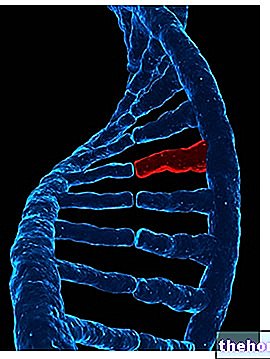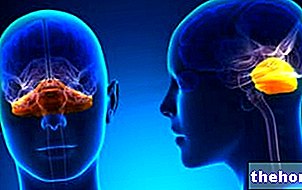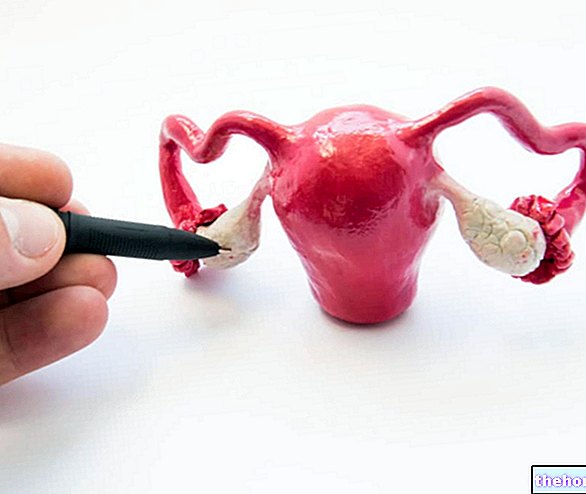Generality
Acoustic neuroma is a benign form of brain tumor. The life of those who carry it is therefore not at risk, but the symptoms (above all, hearing loss and lack of balance), especially if severe, affect most of the daily activities. the triggering causes remain unknown.
The diagnosis is not easy, as, in addition to an accurate neurological control, it also requires considerable intuition on the part of the doctor.
The choice of the most suitable therapy is made on the basis of various evaluations, which concern both the characteristics of the tumor and those of the patient.

Figure: acoustic neuroma or vestibular Schwannoma. It can be seen how the tumor grows in the vestibulocochlear cranial nerve, but also in the vicinity of the facial nerve. From the site: https://baptisthealth.net/
What is a brain tumor
A brain tumor is a mass of cells that forms and expands in a completely abnormal way inside the brain, due to a genetic mutation.
Based on the characteristics with which it presents itself, a brain tumor can be defined in various ways:
- Benign or malignant. Brain tumors characterized by slow growth of the abnormal cell mass are considered benign. Brain neoplasms with fast growth are considered to be malignant.
- Primary or secondary. Primary brain tumors are those that arise directly in the brain or in parts adjacent to it (for example, the meninges or the pituitary gland). Secondary brain tumors, on the other hand, are the result of a process of metastasization , in which the cells of a neoplasm that arose elsewhere (for example, in the lung) have moved and invaded the brain.
In addition, there is a third, more general classification criterion that distinguishes brain tumors according to the degree of severity. There are four grades, from I to IV: the first two (I and II) include slow-growing neoplasms located in a specific area; on the other hand, tumors in rapid and expansive growth are included in the III and IV. However, it is not excluded that a tumor mass of I or II degree evolves and becomes of III or IV degree.
What is acoustic neuroma?
Acoustic neuroma - also known as vestibular Schwannoma - is a benign brain tumor that affects Schwann cells (hence the second name) of the VIII cranial nerve (or vestibulocochlear nerve).
WHAT ARE SCHWANN CELLS?
Schwann's cells are particular cells, which several times envelop the extensions of neurons (axons) and produce myelin, an insulating substance that increases the speed of conduction of the nerve signal. To get an idea of what a Schwann cell is, think of wrapping a slightly swollen balloon (the Schwann cell) around a pencil (the axon of the neuron) many times.

Schwann cells are glia cells and are part of the peripheral nervous system. In general, the glia cells are responsible for providing support and stability to neurons.
L "€ ™ VIII CRANIAL NERVE
The cranial nerves are twelve and are identified with Roman numerals, from I to XII.
L "€ ™ VIII, the so-called vestibulocochlear nerve, is a sensory nerve that controls hearing and balance. It originates in a region of the brain called the brainstem and, like all cranial nerves, is made up of a bundle of multiple neurons. , whose extensions are wrapped in many places by Schwann cells.
EPIDEMIOLOGY
In general, brain tumors are quite rare. According to an English statistic, acoustic neuroma affects approximately 13 people per million inhabitants annually; it is more frequent in women (the reason for this has not yet been clarified) and among individuals aged 40 and over; on the other hand, it is rare among children and young people.
Although a precise cause cannot be recognized in most cases, 5 out of 100 cases are related to a particular congenital condition known as type 2 neurofibromatosis.
Causes
Except for those individuals suffering from type 2 neurofibromatosis, in all other cases the precise causes of origin, which cause the acoustic neuroma, have not yet been fully clarified.
However, since it is a form of brain tumor, the researchers believe that at the origin there is a genetic mutation in the Schwann cells of the VIII cranial nerve.
What this mutation is is still under study.
TYPE 2 NEUROFIBROMATOSIS
Type 2 neurofibromatosis is a benign tumor that affects the nervous system, particularly the cranial and spinal nerves. It is caused by a mutation of the NF2 gene (chromosome 22, protein produced: merlina or schwannomin), which can be transmitted by the parents or arise spontaneously after the formation of the embryo.
Symptoms of type 2 neurofibromatosis consist of bilateral hearing problems, cataracts, skin plaques, peripheral neuropathies, meningiomas and ependymomas.
Symptoms and Complications
For further information: Symptoms Acoustic neuroma
The symptoms that characterize acoustic neuroma appear gradually, as the mass of tumor cells grows slowly and intermittently. The growth rate of the tumor, in fact, is 1-2 mm per year. All this clearly complicates the diagnosis, which, in many cases, is not easy to establish.
The main symptoms of acoustic neuroma consist of acoustic and balance problems; the secondary ones, much rarer than the previous ones, are, instead:
- Headache
- Numbness, tingling and / or pain in one side of the face
- Visual problems (blurred vision)
- Loss of muscle coordination on one side of the body (ataxia)
- Difficulty swallowing and changes in tone of voice
N.B: the slow growth rate characterizes most cases of acoustic neuroma; however, there may be cases where the tumor expands faster.
ACOUSTIC AND BALANCE PROBLEMS
The growth of the tumor, at the level of Schwann cells of the VIII cranial nerve, compromises the control of auditory and balance functions. This explains why individuals with acoustic neuroma suffer from hearing loss, tinnitus and dizziness.
Acoustic problems are almost always felt on one side only (the one governed by the affected nerve), but they can occur on both sides if the origin of the neoplasm is type 2 neurofibromatosis.
COMPLICATIONS
The main complication of an acoustic neuroma is the fact that, if neglected, it can expand more and more, to the point of radically influencing everyday life: hearing loss, dizziness, tinnitus, etc., in fact, make any daily activity difficult (above all, social interaction and work).
The second complication, on the other hand, concerns the possibility of a very serious condition, known as hydrocephalus. In these situations, if the treatments are not timely, there is a real risk that the brain will suffer irreparable damage.
Diagnosis

Figure: nuclear magnetic resonance of an acoustic neuroma (white arrow). From the site: www.bimjonline.com
Since the symptoms appear slowly and resemble those of other pathologies (such as, for example, Ménière's syndrome), it is not at all easy to identify an acoustic neuroma.
To draw up a correct diagnosis, not only neurological checks are needed, but also considerable intuition on the part of the doctor, who must consider the hypothesis on the basis of the signs and symptoms reported by the patient.
Late diagnosis gives the cancer time to expand, even though the growth rate is not fast.
NEUROLIGICAL CONTROLS
When an acoustic neuroma is being researched, neurological checks are targeted and consist of:
- Audiometric tests, to evaluate the patient's acoustic abilities. It analyzes what kind of sounds are perceived and which ones are not perceived.
- Magnetic resonance imaging (MRI), to identify the location and size of the tumor. It is perhaps the most suitable examination to identify acoustic neuroma, as it is reliable and not invasive at all.
- Computed axial tomography (CT), to get an image not only of the brain, but also of the other internal organs. If there is an acoustic neuroma, this is visible, however it should be remembered that the CT uses radiation harmful ionizers.
IMPORTANCE OF A PRECISE DIAGNOSIS
Outlining, through an accurate diagnosis, the characteristics of an acoustic neuroma is essential for setting the most appropriate therapy.
Treatment
Acoustic neuroma can be treated in several ways; before choosing how to act, it is necessary to evaluate the size and position of the tumor, as well as the age and state of health of the patient. In fact, the removal operation is quite delicate and, if the risks associated with it they are greater than the benefits that can be derived from them, so it is better to opt for alternative treatments or wait for any developments.
WHEN TO LIMIT YOURSELF TO MONITORING?
If the acoustic neuroma is small in size and has a very slow growth rate, immediate intervention is not required. The only countermeasure (if we want to define it that way) adopted in these cases is the periodic monitoring of the tumor, by means of nuclear magnetic resonance.
This choice is even more justified if the patient is elderly or in poor health conditions; in such circumstances, in fact, the intervention could represent a greater danger than the tumor itself.
According to a "statistical survey, of acoustic neuromas have a very slow growth rate and are simply kept under control.
THE TUMOR REMOVAL OPERATION
The removal of the acoustic neuroma consists of a microsurgery, to be carried out under general anesthesia and after craniotomy (ie the incision and the opening of the skull, at the point where the tumor is located).
Usually, non-large tumors are eliminated completely and without problems; those of large dimensions, on the other hand, hide various pitfalls, therefore their removal is partial and is completed, at a later time, by radiosurgery.
The operation requires hospitalization for at least a week, and the return to working life occurs after about two months.
Risks, complications and precautions of surgery
The main risk, which is run during surgery, is that of injuring the facial cranial nerve (VII cranial nerve), adjacent to the vestibulocochlear nerve. If the acoustic neuroma is large, the probability of this happening is very high: it is for this reason that the surgeon, in such situations, limits himself to a partial removal of the tumor. From a "€ ™ statistical survey, it emerged that as many as 3 out of 10 people with a large neuroma suffer damage to the facial nerve during the operation."
The other major complication of the surgery is the loss of a large part of hearing. The patient must be informed of this possibility and of the possible need to use a hearing aid to compensate for the hearing loss.
THE RADIO SURGERY INTERVENTION
Radiosurgery is a particular intervention, which makes use of sophisticated instrumentation and can be put into practice both individually and after microsurgery.
Briefly, radiosurgery consists in hitting, with a very intense beam of ionizing radiation, the area occupied by the tumor or what remains of it (if it has already been partially removed).
Performed under local anesthesia, therefore with the patient alert, radiosurgery is particularly suitable for those neuromas located in delicate positions and difficult to access through surgery.
Risks of radiosurgery
Radiosurgery can also damage the cranial nerves or healthy parts of the brain. If this happens, the effects appear several weeks, if not months, and consist of numbness and facial paralysis (one in 100 people) and loss of "€ ™ hearing (one third of the operated).
HOW FREQUENT IS A RELAPSE?
The reappearance of the acoustic neuroma, after surgery, is a rare but possible event. It occurs in 5 cases out of 100. To notice a possible relapse, it is advisable to undergo periodic diagnostic checks.
Prognosis
The prognosis of an acoustic neuroma varies from patient to patient. It depends not only on the same factors that affect the therapeutic choice, but also on the experience of the medical team to whom one relies for treatment.
The factors for a positive prognosis are:
- Small size and slow growth rate of acoustic neuroma: in these cases, intervention is not a priority.
- Good state of health of the patient, which allows him to endure an invasive intervention such as the removal of the tumor.
- Experience and preparation of the medical team that follows the patient: this guarantees the choice of the most appropriate intervention for the acoustic neuroma in question, as well as its best resolution.




























